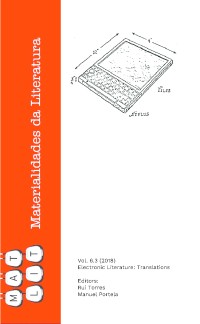Please use this identifier to cite or link to this item:
https://hdl.handle.net/10316.2/44378| DC Field | Value | Language |
|---|---|---|
| dc.contributor.author | Bootz, Philippe | - |
| dc.contributor.author | Laitano, María Inés | - |
| dc.contributor.author | Salceda, Hermes | - |
| dc.date.accessioned | 2018-10-24T09:49:09Z | |
| dc.date.accessioned | 2020-10-04T00:49:39Z | - |
| dc.date.available | 2018-10-24T09:49:09Z | |
| dc.date.available | 2020-10-04T00:49:39Z | - |
| dc.date.issued | 2018 | - |
| dc.identifier.issn | 2182-8830 | - |
| dc.identifier.uri | https://hdl.handle.net/10316.2/44378 | - |
| dc.description.abstract | Nouvelles Impressions d'Afrique é um livro escrito por Raymond Roussel na década de 1920. Trata-se de uma obra que usa muitas estruturas diferentes. É uma das obras literárias francesas mais complexas com recurso a restrições. A restrição mais evidente é o uso massivo de blocos de texto encaixados por conjuntos de colchetes. Mas há muitas outras estruturas baseadas em rimas dispersas, eixos semânticos, homónimos, parónimos, números… Cada uma é usada para construir longas estruturas no texto. Realizamos anteriormente uma remediação digital desta obra com base na transformação da estrutura de colchetes numa estrutura hipertextual. No projeto atual, queremos explorar outra possibilidade que parece mais eficiente para descobrir as outras estruturas. Consiste em animações de texto que desenvolvem progressivamente no tempo as estruturas desde o nó inicial (o conjunto, as rimas...) até às frases finais. Esse tipo de remediação é uma “máquina de leitura” da obra, não uma versão digital do livro, porque o texto de Roussel será o estado final da animação. Planeamos configurar a interface de acordo com várias estruturas de modo a que o leitor possa escolher entre quaisquer delas. Apresentamos um protótipo funcional em linha, aplicado a algumas dessas estruturas, mostrando os conceitos da interface, o modo de reconfiguração de Nouvelles Impressions d'Afrique e de que modo uma animação gerada pode ajudar a ler e entender a literatura produzida segundo restrições. | por |
| dc.description.abstract | Nouvelles Impressions d’Afrique is a book Raymond Roussel wrote in the 1920’s. This book uses many different structures. It is one of the most complex French literary works in constrained literature. The most evident constraint is the massive use of text blocks slotted in by sets of brackets. But there are many other structures based on dispersed rimes, semantic axes, homonyms, paronyms, numbers... Each is used to build long structures in the text. We have previously done a digital remediation of this work based on the transformation of the bracket structure into a hypertextual structure. In the current project, we want to explore another possibility that seems more efficient to discover the other structures. It consists in text animations that progressively develop and unfurl in time the structures from their initial node (the set, the rhymes...) to the final sentences. This kind of remediation is a “reading machine” of the work, not a digital version of the book because Roussel’s text will be the final state of the animation. We plan to configure the interface according to several structures so that the reader would choose between any of them. We present a functional online prototype applied to some of those structures, showing the concepts of the interface, how Nouvelles Impressions d’Afrique will be reconfigured and how a generated animation can help to read and understand constrained literature. | eng |
| dc.language.iso | eng | - |
| dc.publisher | Centro de Literatura Portuguesa | - |
| dc.publisher | Imprensa da Universidade de Coimbra | - |
| dc.rights | open access | - |
| dc.subject | remediation | eng |
| dc.subject | complex structures | eng |
| dc.subject | reading machine | eng |
| dc.subject | hypertext | eng |
| dc.subject | remediação | por |
| dc.subject | estruturas complexas | por |
| dc.subject | máquina de leitura | por |
| dc.subject | hipertexto | por |
| dc.title | Remediation of Nouvelles Impressions d’Afrique by Raymond Roussel: functional issue | por |
| dc.type | article | - |
| uc.publication.collection | Matlit v. 6, nº 3 | - |
| uc.publication.firstPage | 35 | - |
| uc.publication.issue | 3 | - |
| uc.publication.lastPage | 46 | - |
| uc.publication.location | Coimbra | - |
| uc.publication.journalTitle | MATLIT: Materialidades da Literatura | - |
| uc.publication.volume | 6 | por |
| dc.identifier.doi | 10.14195/2182-8830_6-3_3 | - |
| uc.publication.orderno | 3 | - |
| uc.publication.area | Artes e Humanidades | - |
| uc.publication.manifest | https://dl.uc.pt/json/iiif/10316.2/44378/263688/manifest?manifest=/json/iiif/10316.2/44378/263688/manifest | - |
| uc.publication.thumbnail | https://dl.uc.pt/retrieve/12074402 | - |
| item.grantfulltext | open | - |
| item.fulltext | With Fulltext | - |
| Appears in Collections: | Matlit | |
Files in This Item:
| File | Description | Size | Format | |
|---|---|---|---|---|
| remediation_of_nouvelles_impressions_d_afrique.pdf | 1.05 MB | Adobe PDF |  |
Items in DSpace are protected by copyright, with all rights reserved, unless otherwise indicated.
